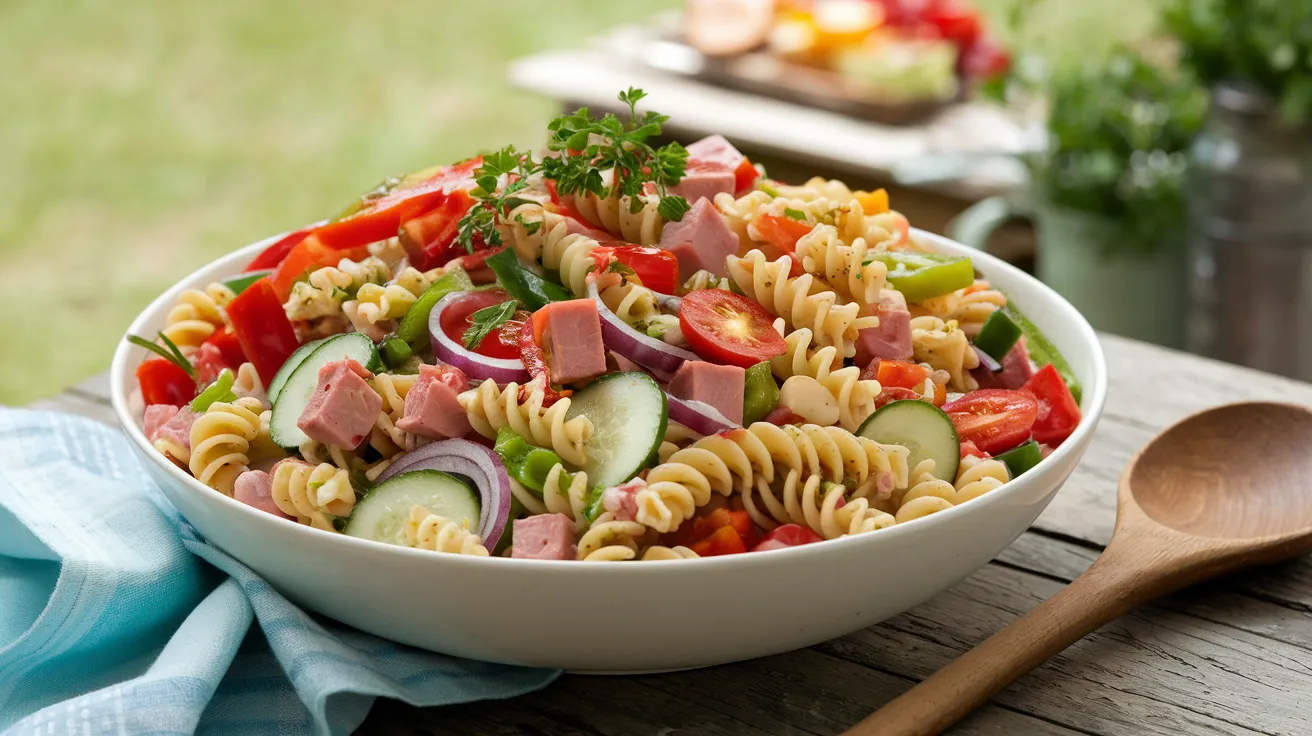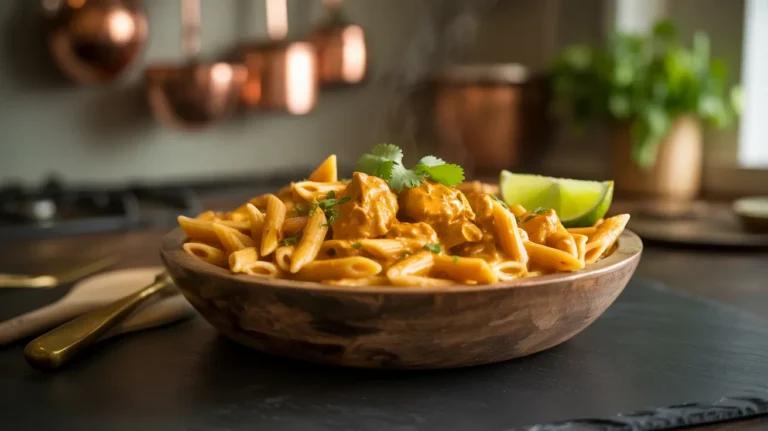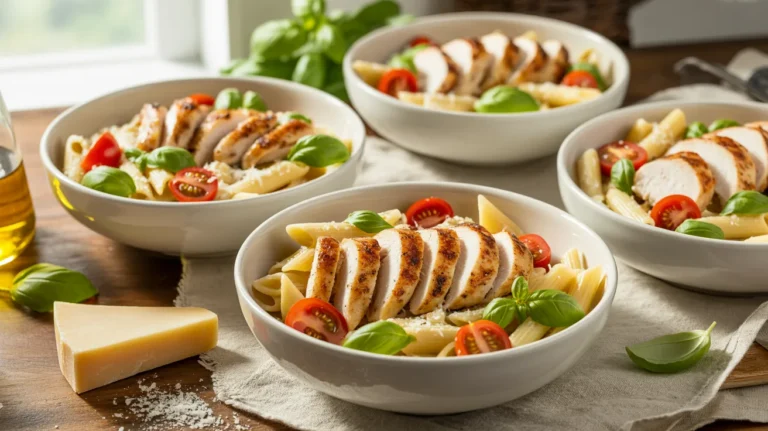Prep Time: 15 minutes | Cook Time: 10 minutes | Total Time: 25 minutes (+ 1 hour chilling) | Servings: 4
Key Takeaways
- This authentic German Pasta Salad combines tangy vinegar dressing with crisp vegetables and savory ham
- Perfect make-ahead dish that tastes even better after chilling for 1-24 hours
- Great for beginners with simple ingredients and only 25 minutes of active preparation
- Travels well for potlucks, picnics, and outdoor gatherings
Introduction
Finding the perfect side dish for your summer barbecue can be challenging. You want something filling enough to satisfy hungry guests but light enough to complement grilled meats.
This German Pasta Salad recipe solves that problem. Unlike mayo-heavy American versions, this authentic German Pasta Salad uses a tangy vinegar-based dressing that won’t spoil in the heat. With a perfect balance of pasta, vegetables, and savory ham, it’s a crowd-pleaser that can be made ahead and actually improves with time.
If you love pasta with bold flavors, you might also enjoy my Garlic Chilli Cacio e Pepe for something with a bit more heat.
Nutrition Comparison
| Nutrient | German Pasta Salad | Mayo-Based Pasta Salad | Potato Salad |
|---|---|---|---|
| Calories | 320 per serving | 450 per serving | 358 per serving |
| Fat | 9g | 28g | 20g |
| Carbs | 48g | 45g | 42g |
| Protein | 14g | 8g | 7g |
| Shelf Life | 3-4 days refrigerated | 1-2 days refrigerated | 3-4 days refrigerated |
Equipment & Ingredients
Kitchen Tools Needed
| Tool | Purpose |
|---|---|
| Large pot (4-5 quart) | Cooking pasta |
| Colander | Draining pasta |
| Large mixing bowl (at least 4 quart) | Combining ingredients |
| Cutting board | Chopping vegetables |
| Sharp chef’s knife | Cutting ingredients |
| Measuring cups & spoons | Measuring ingredients accurately |
| Whisk | Making dressing |
| Wooden spoon or rubber spatula | Mixing salad |
| Plastic wrap or container with lid | Storing finished salad |
| Small bowl | Mixing dressing |
Ingredients List
| Ingredient | Amount | Notes |
|---|---|---|
| Rotini pasta | 1 pound (16 oz) | Can substitute fusilli or farfalle |
| Black forest ham | 8 oz | Diced into small cubes |
| Red bell pepper | 1 medium | Diced |
| Green bell pepper | 1 medium | Diced |
| Red onion | 1/2 medium | Finely diced |
| English cucumber | 1/2 medium | Quartered and sliced |
| Cherry tomatoes | 1 cup | Halved |
| Fresh parsley | 1/4 cup | Chopped |
| White vinegar | 1/3 cup | |
| Vegetable oil | 1/4 cup | |
| Dijon mustard | 2 tablespoons | |
| Sugar | 1 teaspoon | |
| Salt | 1 teaspoon (plus 1 tablespoon for pasta water) | |
| Black pepper | 1/2 teaspoon | Freshly ground |
| Garlic powder | 1/2 teaspoon | |
| Dried dill | 1 teaspoon |
Substitution Options
- Pasta: Any short pasta works well (penne, bow ties, shells)
- Meat: Substitute smoked turkey, salami, or omit for vegetarian version
- Vegetables: Add or substitute carrots, celery, or corn
- Vinegar: Apple cider vinegar or white wine vinegar can replace white vinegar
- Oil: Olive oil can substitute for vegetable oil for a different flavor profile
- Herbs: Fresh dill can replace dried (use 1 tablespoon)
Super-Detailed Step-by-Step Instructions for Beginners
Preparation Phase
- Gather all ingredients and tools
- Take out all ingredients from refrigerator and pantry
- Place them on your counter so everything is visible
- Check that you have all required tools listed in the equipment table
- Tip: Read through the entire recipe once before starting
- Set up your pasta cooking station
- Place your large pot on the stove
- Fill it with approximately 4 quarts (16 cups) of cold water
- Leave about 2 inches from the top to prevent boiling over
- Add 1 tablespoon of salt to the water (this seasons the pasta from within)
- Place the colander in your sink so it’s ready for draining
- Beginner’s tip: Salt the water generously – it should taste like seawater
- Set up your chopping station
- Place your cutting board on a flat, stable surface
- Keep your sharp knife nearby
- Set out a few small bowls or plates to hold chopped ingredients
- Have your measuring cups and spoons within reach
- Safety tip: Place a damp paper towel or cloth under your cutting board to prevent slipping
- Start heating pasta water
- Turn stove burner to high heat
- Cover pot with lid to make water boil faster
- Water will take 8-10 minutes to reach a boil
- While waiting, proceed to vegetable preparation
Vegetable and Ingredient Preparation
- Prepare the bell peppers
- Wash both peppers under cold running water
- Place pepper on cutting board with stem side up
- Cut around the stem to remove it
- Slice pepper in half from top to bottom
- Remove all white membrane and seeds
- Place pepper cut-side down on cutting board
- Slice into thin strips (about 1/4 inch wide)
- Turn strips 90 degrees and cut into 1/4-inch dice
- Transfer diced peppers to a bowl or plate
- Beginner’s tip: Keep your fingertips tucked under while cutting to prevent cuts
- Prepare the red onion
- Cut onion in half from top to bottom (through root end)
- Peel off the outer skin and first layer
- Place one half cut-side down on board (save other half for another use)
- Make horizontal cuts parallel to board (but don’t cut through root end)
- Make vertical cuts from top to bottom (don’t cut through root)
- Slice across the onion to create small dice
- Beginner’s tip: Refrigerate onion for 30 minutes before cutting to reduce tears
- Prepare the cucumber
- Wash cucumber under cold running water
- Cut off both ends
- Slice in half lengthwise
- Slice each half lengthwise again to make quarters
- Cut quarters into 1/4-inch slices
- Beginner’s tip: If using regular cucumber (not English), peel it first and scoop out seeds
- Prepare the cherry tomatoes
- Wash tomatoes under cold running water
- Pat dry with paper towel
- Place tomatoes on cutting board
- Hold several tomatoes gently with fingers tucked under
- Use a serrated knife to cut each tomato in half
- Beginner’s tip: Place tomatoes between two plastic lids and slice through the middle for quick halving
- Prepare the ham
- Remove ham from packaging
- Stack 2-3 slices at a time
- Cut into strips about 1/2 inch wide
- Turn strips 90 degrees and cut into 1/2-inch cubes
- Beginner’s tip: If ham is sticking to knife, wipe blade clean between cuts
- Prepare the parsley
- Wash parsley bunch under cold running water
- Shake off excess water
- Pat dry with paper towel
- Remove leaves from stems
- Gather leaves into a tight pile
- Use rocking motion with knife to chop finely
- Beginner’s tip: Hold tip of knife on cutting board and rock the blade to chop herbs evenly
Cooking the Pasta
- Cook the pasta
- Once water is at a full rolling boil (large bubbles breaking the surface)
- Remove lid from pot
- Add 1 pound of rotini pasta to boiling water
- Stir immediately with wooden spoon to prevent sticking
- Set a timer for exactly 8 minutes (or according to package directions for “al dente”)
- Stir occasionally during cooking
- Beginner’s warning: Don’t add oil to pasta water – it prevents sauce from sticking later
- Beginner’s warning: Don’t cover the pot – it may cause water to boil over
- Test pasta for doneness
- When timer goes off, carefully remove one pasta piece with spoon
- Run it under cold water for a few seconds to cool
- Taste it – pasta should be tender but still firm to the bite (“al dente”)
- If too firm, continue cooking and check every 30 seconds
- Beginner’s tip: Pasta will continue cooking slightly after draining, so err on the firmer side
- Drain and cool the pasta properly
- When pasta is al dente, turn off heat
- Place colander securely in sink
- Carefully pour pasta and water into colander (beware of steam!)
- Immediately rinse pasta with cold running water
- Gently stir pasta while rinsing to cool all pieces quickly
- Continue rinsing until pasta feels cool to the touch (about 1-2 minutes)
- Shake colander several times to remove excess water
- Beginner’s warning: Don’t skip rinsing – it stops cooking and removes starch that causes sticking
- Prevent pasta from sticking
- Transfer cooled pasta to large mixing bowl
- Add 1 tablespoon of vegetable oil
- Gently toss with wooden spoon or rubber spatula until pasta is lightly coated
- Let pasta cool completely for 5-10 more minutes
- Beginner’s tip: Spread pasta in an even layer in bowl for fastest cooling
If you enjoy creamy pasta dishes as well, check out my Creamy Harissa Pasta for something with a spicy kick!
Making the Dressing
- Prepare the dressing ingredients
- Place small bowl on counter
- Measure out all dressing ingredients using proper measuring tools:
- 1/3 cup white vinegar
- 1/4 cup vegetable oil
- 2 tablespoons Dijon mustard
- 1 teaspoon sugar
- 1 teaspoon salt
- 1/2 teaspoon black pepper
- 1/2 teaspoon garlic powder
- 1 teaspoon dried dill
- Beginner’s tip: For liquids, fill measuring cups on a flat surface and check at eye level
- Mix the dressing properly
- Add all measured dressing ingredients to small bowl
- Whisk vigorously for 30-60 seconds until well combined
- Mixture should look slightly thickened and uniform in color
- Taste a tiny amount on spoon tip and adjust seasonings if needed
- Beginner’s tip: Hold bowl with one hand while whisking with the other to prevent spinning
Final Assembly and Chilling
- Combine all ingredients
- Make sure pasta is completely cooled
- Add all prepped vegetables to pasta in the large bowl:
- Diced red pepper
- Diced green pepper
- Diced red onion
- Sliced cucumber
- Halved cherry tomatoes
- Add diced ham
- Sprinkle with chopped parsley (reserve a little for garnish if desired)
- Beginner’s tip: Add ingredients in stages so bowl doesn’t overflow while mixing
- Add dressing and mix thoroughly
- Whisk dressing again briefly just before adding
- Pour dressing evenly over salad ingredients
- Using wooden spoon or rubber spatula, gently fold and toss
- Start from bottom of bowl and lift ingredients up and over
- Continue folding for 1-2 minutes until all pasta and vegetables are evenly coated
- Beginner’s warning: Don’t stir too vigorously or you’ll break the pasta
- Taste and adjust seasonings
- Use a clean spoon to taste a small portion
- Add more salt, pepper, or vinegar if needed
- Mix gently again if adjustments were made
- Beginner’s tip: It’s better to slightly under-season now – flavors will intensify during chilling
- Chill properly
- Cover bowl tightly with plastic wrap
- Or transfer to airtight container with lid
- Place in refrigerator
- Chill for minimum 1 hour, ideally 2-4 hours
- Beginner’s tip: Place salad on middle shelf of refrigerator where temperature is most consistent
Serving the Salad
- Prepare for serving
- Remove salad from refrigerator 15 minutes before serving
- This takes the chill off and allows flavors to come through better
- Stir gently to redistribute dressing that may have settled
- Taste and make final adjustments if needed
- Sprinkle with any reserved parsley for garnish
- Transfer to serving bowl if desired
- Beginner’s tip: Use a clean spoon each time you taste to prevent contamination
- Serve and store promptly
- Use large serving spoon or tongs to portion salad
- Return any leftovers to refrigerator within 2 hours
- Food safety warning: Never leave pasta salad at room temperature for more than 2 hours (1 hour if above 90°F)

Troubleshooting
| Problem | Cause | Solution |
|---|---|---|
| Pasta is mushy | Overcooked pasta | Cook pasta until just al dente; rinse immediately with cold water |
| Salad is dry | Not enough dressing or absorbed overnight | Reserve 2-3 tablespoons of dressing to add just before serving |
| Vegetables are soggy | Cut too small or salad sat too long | Cut vegetables slightly larger; add crunchier vegetables just before serving |
| Flavors are bland | Under-seasoned | Add more salt, pepper, or a splash of vinegar to brighten flavors |
| Pasta sticks together | Not enough oil after cooking | Toss pasta with a bit of oil immediately after draining and cooling |
| Dressing separates | Natural settling | Stir well before serving to reincorporate ingredients |
| Pasta absorbed all dressing | Normal occurrence over time | Make a small amount of extra dressing to refresh before serving |
Variations & Substitutions
Protein Variations
- Vegetarian: Omit ham and add 1 cup diced cheese (Swiss or Gouda) and 1/2 cup toasted sunflower seeds
- Seafood: Replace ham with 1 1/2 cups cooked, peeled, and deveined shrimp
- Vegan: Omit ham and add 1 cup diced smoked tofu or 1 can drained chickpeas
Dressing Variations
- Creamy German: Add 2 tablespoons sour cream to the dressing
- Herb-Forward: Add 1 tablespoon each of fresh chopped chives, dill, and parsley
- Sweet-Sour: Increase sugar to 1 tablespoon for a sweeter dressing
For a completely different pasta experience, try my Baked Brie Pasta for something rich and indulgent.
Dietary Modifications
- Gluten-Free: Use gluten-free pasta (cooking time may vary)
- Lower Carb: Replace half the pasta with extra vegetables or cauliflower florets
- Heart-Healthy: Use olive oil instead of vegetable oil and reduce ham to 4 oz
Storage & Reheating
Storage Guidelines
- Store in airtight container in refrigerator for up to 3-4 days
- Do not freeze – pasta and vegetables will become mushy when thawed
Refreshing Leftovers
- Remove from refrigerator 15-20 minutes before serving
- Add a splash of vinegar or lemon juice to brighten flavors
- Toss with a drizzle of fresh oil if salad seems dry
- Add fresh herbs like parsley or dill to refresh appearance
Safety Notes & Tips
Food Safety
- Wash hands with soap and water for 20 seconds before beginning
- Wash all produce thoroughly under running water
- Keep raw meat separate from other ingredients
- Never leave salad at room temperature for more than 2 hours (1 hour if temperature is above 90°F)
- Keep chilled in cooler with ice packs for picnics or outdoor events
- Use separate cutting boards for vegetables and ham to prevent cross-contamination
Make-Ahead Tips
- Prepare up to 24 hours in advance for best flavor
- Cook pasta the day before, toss with a little oil, and refrigerate in an airtight container
- Cut vegetables the day before and store in separate containers in the refrigerator
- Combine everything with dressing 2-4 hours before serving for optimal flavor
- Beginner’s tip: If making more than a day ahead, keep pasta and dressing separate until a few hours before serving
Serving Tips
- Serve in a wide, shallow bowl for best presentation
- Garnish with additional fresh herbs just before serving
- Provide tongs or a large serving spoon for easy self-service
- Serve cold but not ice-cold for best flavor
Common Mistakes to Avoid
- Don’t use hot pasta – it will make vegetables wilt and absorb too much dressing
- Don’t skimp on chilling time – this German Pasta Salad needs time for flavors to develop
- Don’t cut vegetables too small – they’ll release water and become soggy
- Don’t overdress – you can always add more dressing but can’t take it away
- Don’t substitute dried herbs for fresh in garnishes – fresh herbs provide better color and flavor
- Don’t skip salting the pasta water – it’s your only chance to season the pasta itself




